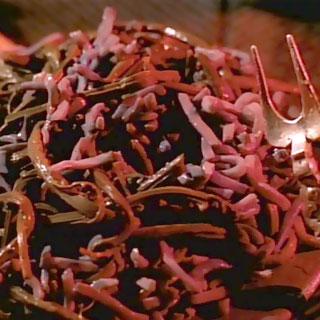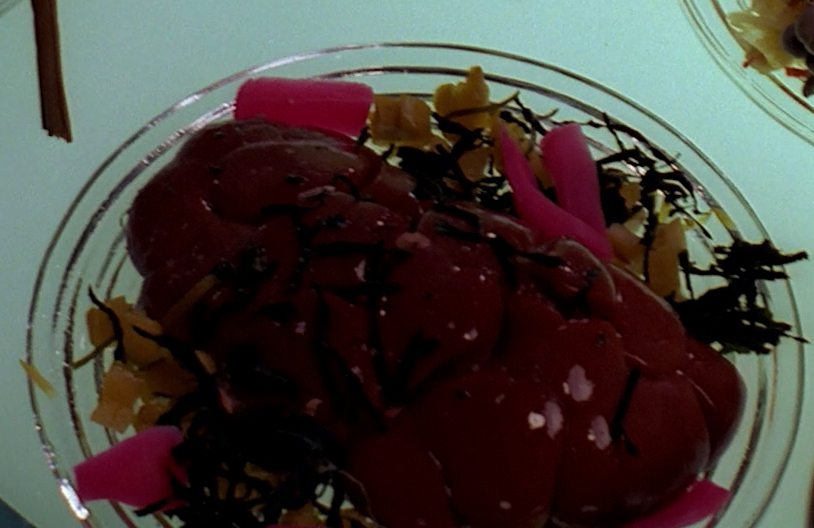Greetings, Fellow Warriors! As previously discussed, there are many little elements that make up being a Klingon.
As we have seen in several episodes of the different Star Trek series, Klingons have unique and bizarre appetites and cuisines. This month we will explore some Klingon recipes that have been modified for human consumption.
All these recipes can be found by clicking HERE The IKS Tiburon is a proud member of the Klingon Assault Group.
Gagh makes 3-4 portions
- 7 oz pre-cooked udon noodles (aka Japanese wheat-flower noodles)
- 2 oz dry (uncooked) soba noodles (aka Japanese buckwheat noodles)
- 2 oz dry (uncooked) udon noodles
- 6 scallions, chopped
- 3 eggs, beaten
- 3/4 cup bean sprouts
- 1 package fried rice seasoning
- Low sodium soy sauce
Cooking oil (I recommend a blend of equal portions sunflower and olive)
Food Coloring (I recommend red and black)
1. Boil the noodles in water with ~2 Tbsp. soy sauce and food coloring (~2:1 red:black). Simmer until desired tenderness. Drain.
2. In a frying pan, heat ~2 Tbsp. cooking oil and ~2 tsp. soy sauce. Stir-fry all of the scallions and bean sprouts. Add eggs a little at a time, mixing constantly.
3 Add the cooked noodles to the stir-fry. Add fried rice seasoning and ~2 Tbsp. more cooking oil. Mix constantly and thoroughly to achieve a homogeneous mixture.
Plate and serve.
Although Klingons are known for their love of meats, this recipe is mostly vegetarian. Might I recommend adding and substituting ingredients, perhaps creating a variation of beef lo mein, or even scrambling and egg to add texture. One great thing about any recipe is experimenting and making it your own.
Heart of Targ: 
- 6 lamb’s hearts
- 1 head of kale, sliced into thin strips
- 6 stalks of celery, sliced into small pieces
- ½ cup water
- Vegetable oil
- For the sauce:
- 1 cup red wine
- 2 tablespoons brown sugar
- 2 tablespoons Worcestershire sauce
- 1 tablespoon cornstarch
Start by preparing the hearts. Trim the hearts to remove any fat and tubes still remaining on the hearts. You will probably need to trim a fair bit. Slice them into thin slices and set aside.
Next, prepare the sauce. Put the red wine in a saucepan and heat gently. Add the sugar and stir until it is dissolved. Add the Worcestershire sauce to make the sweet and sour sauce.
In a separate bowl, add the cornstarch and a splash of the red wine, and stir to form a slurry. Add this to the saucepan with the wine and stir. The cornstarch will thicken the wine as it heats. You may need to add another round of cornstarch slurry if the sauce does not thicken sufficiently.
In a large saucepan or wok, add the water and heat until it starts to steam. Add the celery pieces and cook for a few minutes, until they begin to soften. When they are the texture you like, add the kale. Cook for a few minutes, until kale softens slightly (but still remains bright green and holds its shape). Remove the celery and kale and tip out any remaining water.
When the wok or saucepan is dry, add a splash of vegetable oil and heat. You want the wok / saucepan to be fairly hot before you add the hearts. Add the hearts and stir around the saucepan / wok. You will only need to cook them for a couple of minutes – do not overcook or they will be very chewy.
Turn off the heat and add the sauce to the hearts. Toss or stir around the pot until the hearts are thoroughly coated in the sauce.
To serve, place some of the kale and celery mix onto a plate or bowl. Add the hearts in the middle of the greens, adding extra sauce if desired.
Substitutions may be needed in all recipes due to diet restrictions and allergies. I have had a variation of this dish made with steak medallions due a diner’s allergies to lamb. Perhaps cooking with wine or other alcohol is uncomfortable. There are many ways to recreate this dish and still call it Klingon cuisine.
For our last recipe, I am including two, one for those who wish to experience the taste of blood wine and another for those who wish to experience both the taste and the effects of a good blood wine.
Be warned that there are many different recipes for blood wine, and these are just suggestions. If you have your own recipes or have had the honor of trying someone else’s then Qapla, you already know blood wine. For those who haven’t, here are some suggestions.
Blood Wine (non-alcoholic)
Use a very dark grape juice or cranberry juice, but use a food processor, maybe a blender, or, even better, a juicer and fresh cranberries. Then you use the juice and the cranberry residue – it looks like bloody organic tissue, very clotty, and you can even put some red gelatin in there to make it seem like it is clotting up even more.
For people who can’t drink sugar beverages, use straight-up cranberry juice, the blended mash of cranberries, and sugar-free strawberry, raspberry, grape, or cherry gelatin that’s just beginning to congeal.
Blood Wine (alcoholic)
(Makes 1.5 liters / 1.5 quarts cocktail – scale up or down as needed) You will need a glass jar or vessel that can hold about 2 liters / 2 quarts of liquid and is possible to be sealed to stop anything from getting in it. You will need to start 6-8 weeks in advance.
- 500ml Gin (I used Tanqueray)
- 500ml Red Vermouth
- 500ml Campari
Handful of wine barrel chips, available at home brew stores or online. I used French Oak, but you can of course choose which one you prefer.
Rinse out your glass jar with boiling water – you don’t need to make sure it is sterilized, but just give it a quick rinse.
Add the wine barrel chips to the bottom of your jar. Pour the gin, red vermouth and Campari over the chips. The chips will probably float to the surface.
Put the lid on your jar and give it a few shakes to mix everything together. Place the jar in a cool, dark location and leave for 6-8 weeks to age. Every week or so, give the jar another shake. The chips will fall to the bottom as they absorb the liquid.
To serve, fill a tumbler with ice and pour the blood wine over the top. Stir together. Top with a garnish of lemon or orange peel.
Again, Warriors, these are just suggestions on Klingon dishes; part of the art of cooking is experimentation, as I have already stated. A true warrior can make any dish Klingon if they try.
